Samsung Galaxy S series evolution

It took Samsung some time to become the big smartphone manufacturer that it is today.
It can be argued that the main driving force that kickstarted the company's rise to the top of the market was its flagship Galaxy S smartphone lineup, which debuted in 2010 and has gradually positioned itself as a force to be reckoned with on the smartphone market.
Let's look back at the history of the Galaxy S series, probably the most successful Android-powered smartphone lineup so far!
History of Samsung Galaxy S series (in descending order):
- Galaxy S25 / S25 Plus / S25 Ultra (2025)
- Galaxy S24 / S24 Plus / S24 Ultra (2024)
- Galaxy S23 / S23 Plus / S23 Ultra (2023)
- Galaxy S22 / S22 Plus / S22 Ultra (2022)
- Galaxy S21 / S21 Plus / S21 Ultra (2021)
- Galaxy S20 / S20 Plus / S20 Ultra (2020)
- Galaxy S10 / S10 Plus / S10e (2019)
- Galaxy S9 / S9 Plus (2018)
- Galaxy S8 / S8 Plus (2017)
- Galaxy S7 / S7 Edge (2016)
- Galaxy S6 / S6 Edge (2015)
- Galaxy S5 (2014)
- Galaxy S4 (2013)
- Galaxy S III (2012)
- Galaxy S II (2011)
- Galaxy S (2010)
Samsung Galaxy S25, S25 Plus and S25 Ultra (2025)
Release date: Feb 7, 2025
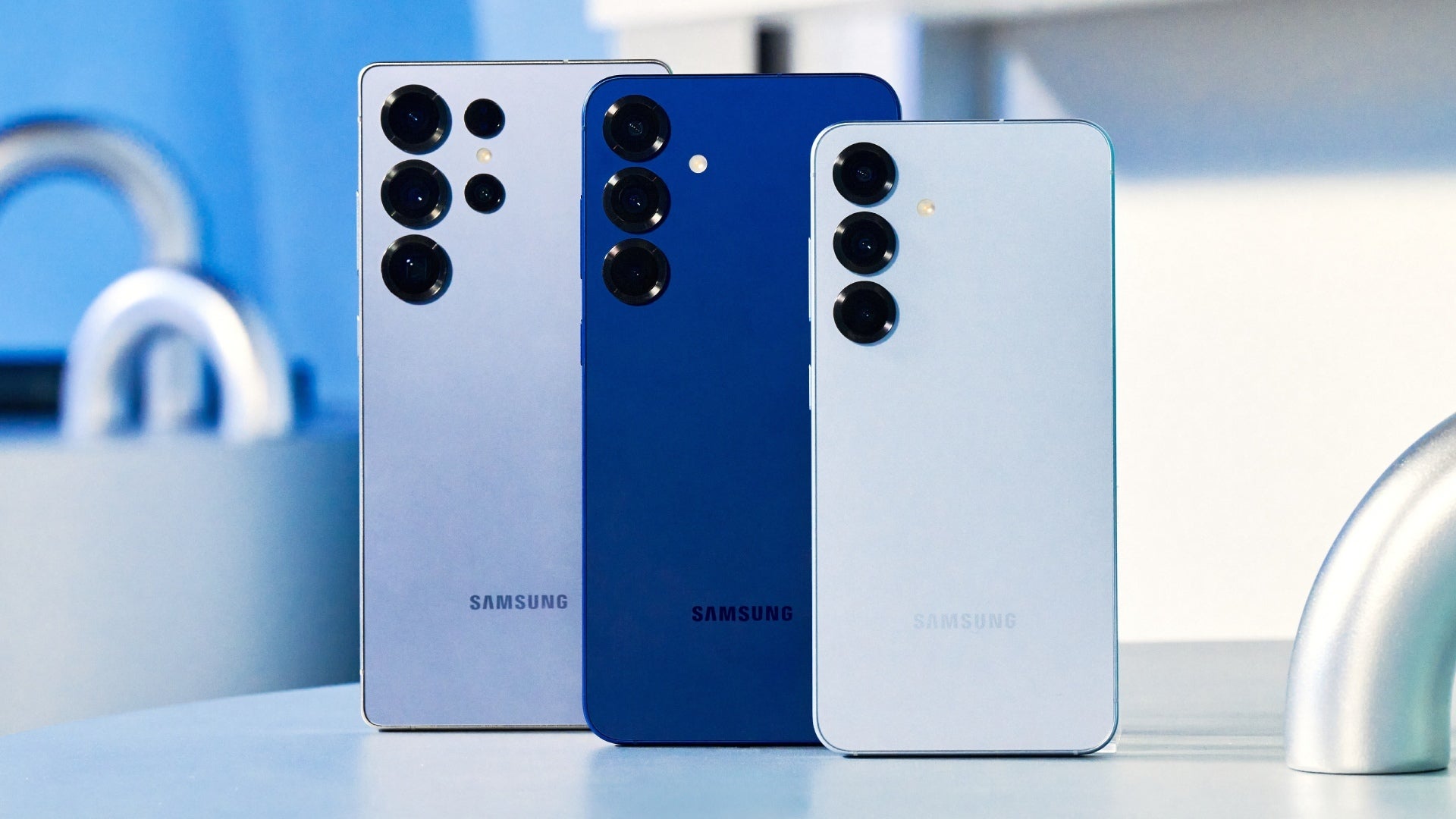
Samsung Galaxy S25 series (Image Credit - Samsung
Announced in early 2025, the Galaxy S25 series is the first range of Samsung phones to come with a 3nm chip, the Snapdragon 8 Elite for Galaxy. All new phones feature the same flat design language and are more compact than the Galaxy S24 series. The Ultra model uses titanium still, while the Galaxy S25 Plus and Galaxy S25 rely on Armor Aluminum once again.
The Galaxy S25 Ultra scored a slightly larger 6.9-inch screen (up from (6.8 inches), but the smaller two flagships didn't score a similar change.
The recurring theme with the new Galaxies remains AI, with Samsung bringing a ton of Gemini AI features to the Galaxy S25 series (though many of them will be available on older Galaxies as well).
Although the Galaxy S25 Ultra scored a new 50MP ultrawide camera, little has changed with the overall camera systems of these phones. However, Samsung has embedded a new ProVisual Engine for enhanced image-processing on the Galaxy S25 series, which delivers a very different image processing to the range. As a result, the phones no longer suffer from oversharpening and boast much better image quality from the same hardware.
Samsung Galaxy S24, S24 Plus and S24 Ultra (2024)
Released: Jan 31, 204
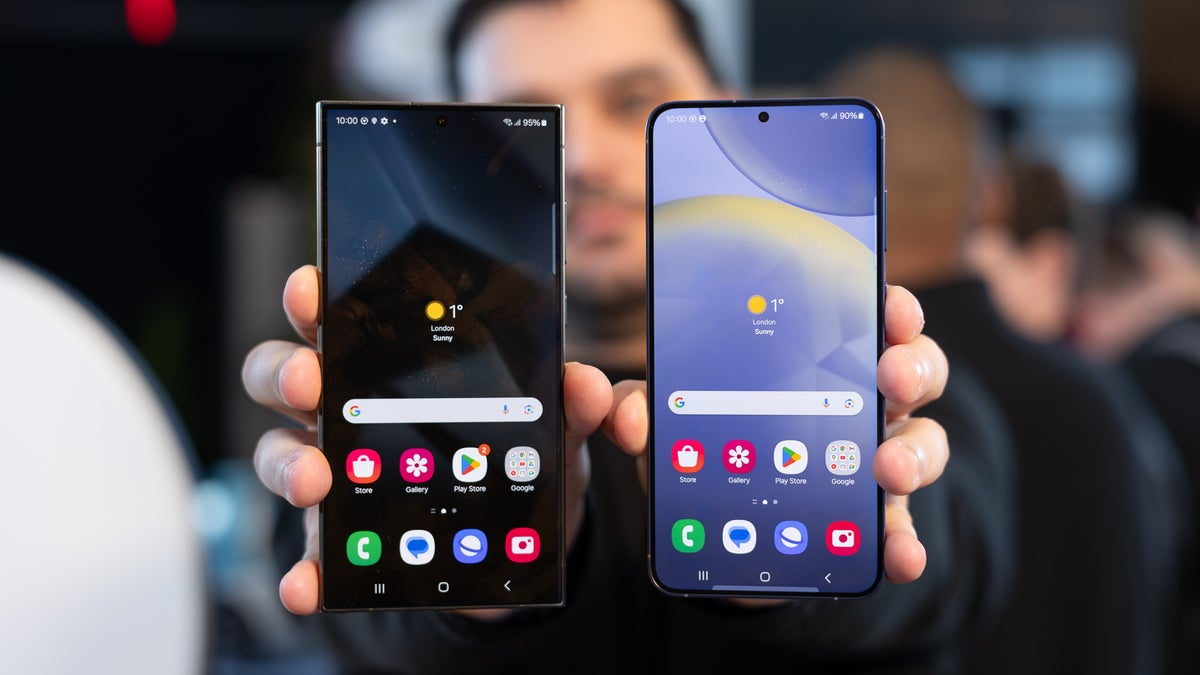
The Galaxy S24 series was a pretty monumental release for Samsung.
The Samsung Galaxy S24 Ultra refines its flagship formula with a new titanium frame, brighter 2,600-nit AMOLED display, and AI-powered features. The flatter sides improve grip, and Gorilla Glass Armor boosts durability. S Pen support remains exclusive to the Ultra.
A major camera change is the new 50MP 5X zoom lens, replacing the 10X periscope. While 100X Space Zoom stays, AI enhances hybrid 10X shots. Galaxy AI adds Circle to Search, Live Translate, and AI photo edits.
Powered by the Snapdragon 8 Gen 3 for Galaxy, it offers better efficiency. The 5,000mAh battery lasts longer, though charging remains 45W wired, 15W wireless. While not a huge leap, design, AI, and camera tweaks make it a solid upgrade, especially for older models.
Powered by the Snapdragon 8 Gen 3 for Galaxy, it offers better efficiency. The 5,000mAh battery lasts longer, though charging remains 45W wired, 15W wireless. While not a huge leap, design, AI, and camera tweaks make it a solid upgrade, especially for older models.
Meanwhile, the regular Galaxy S24 Plus and Galaxy S24 remained mostly similar to their predecessors, but with the annual hardware refresh inside.
Samsung Galaxy S23, S23 Plus and S23 Ultra (2023)
Released: Feb 17, 2023
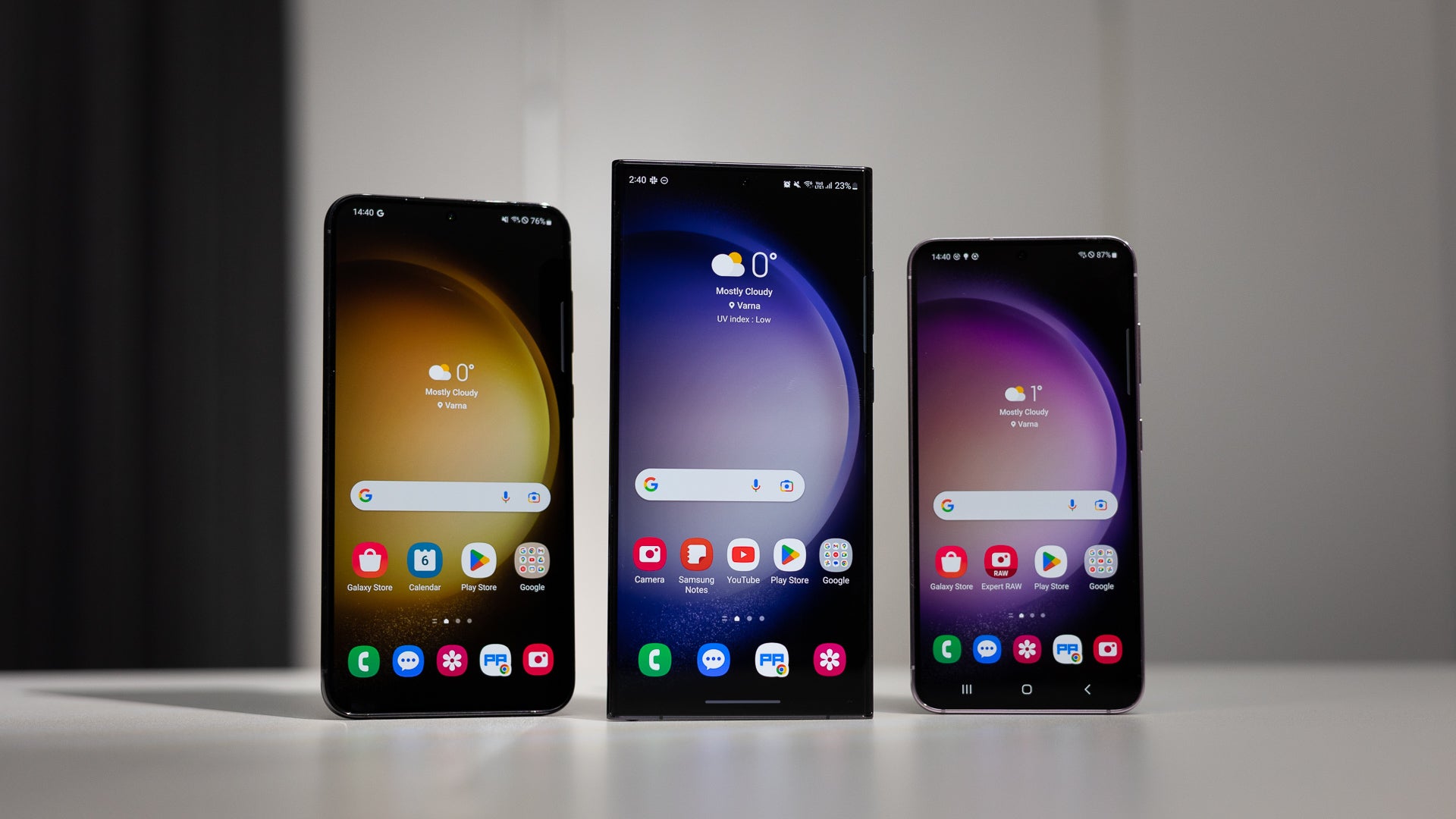
The Galaxy S23 series marks a decisive moment for Samsung as it no longer uses an Exynos chip for the international versions of its flagships, and switches to Qualcomm Snapdragon chips for all versions.
And the new Snapdragon 8 Gen 2 chip in the S23 series is a beast that delivers a solid upgrade in speeds and future proofs the devices. You also get an unexpected boost in battery life that, plus a few improvements in the camera system. Overall, a pretty decent entry to the Galaxy S series.
Unfortunately, while US prices remain the same, international customers get a noticeable price hike. Still, the Galaxy S23 series are a successful launch and one of the best refined series Samsung has ever produced so far.
Samsung Galaxy S22, S22 Plus and S22 Ultra (2022)
Released: Feb 25, 2022
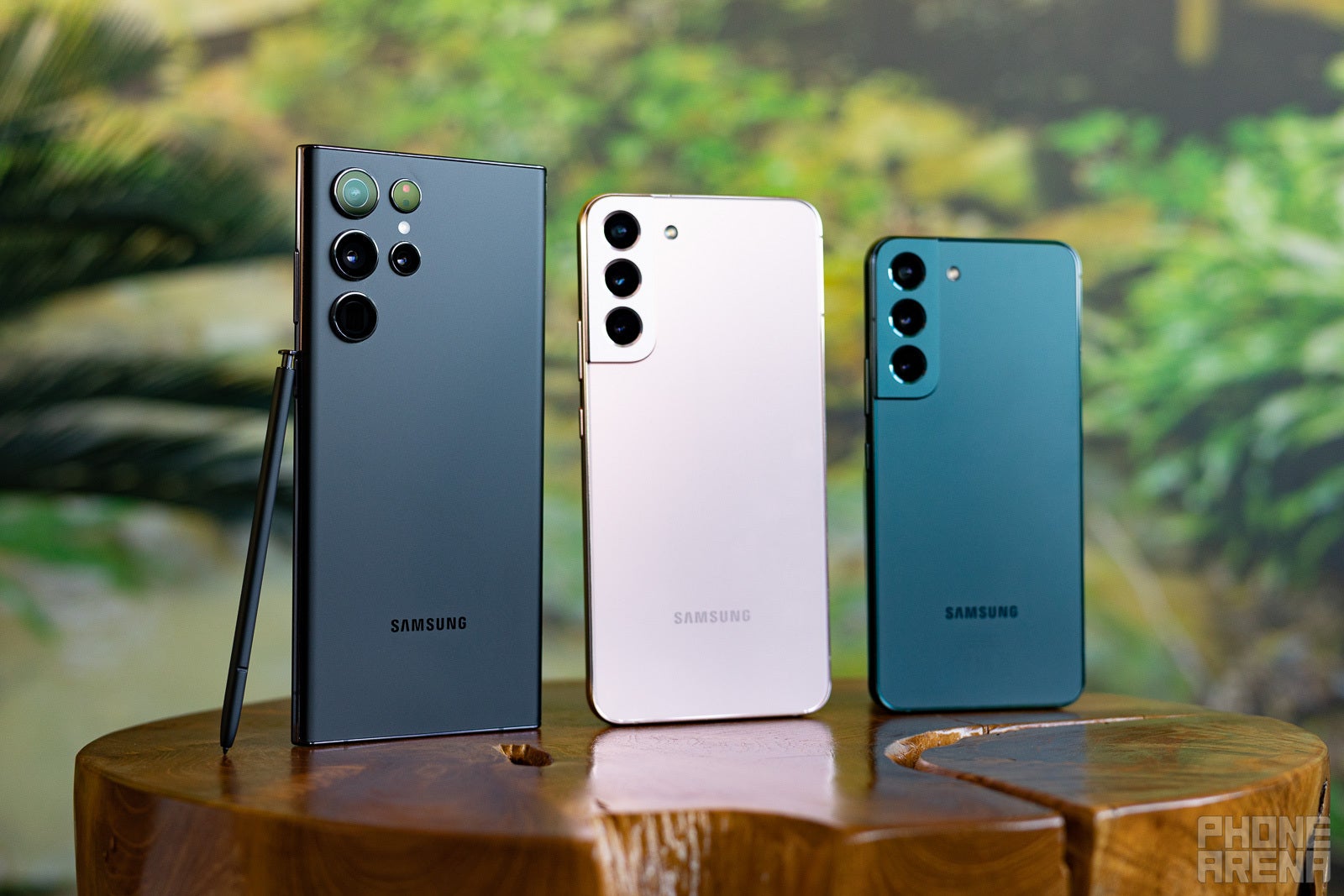
The Galaxy S22 series arrived in early 2022, and brought a change in aspect ratio and an Ultra model that for the first time in the series featured a built-in S Pen and a squared off design, much like a Galaxy Note phone. This all made sense considering Samsung killed the Note series earlier, so essentially it moved the key Note feature to the S series.
The S22 Ultra retained the familiar quad-camera setup, with a 3X and a 10X zoom cameras in addition to the main and ultra-wide shooters.
With improvements to the cameras and a commitment to longer software updates, the S22 series were a gradual improvement.
One interesting fact is that the S22 was actually smaller than its predecessor and had a smaller battery too, a change from ever-growing screen sizes in the industry.
Samsung Galaxy S21, S21 Plus and S21 Ultra (2021)
Released: Jan 29, 2021

The Galaxy S21 series comes in three flavors: the compact, 6.2" Galaxy S21, the larger-screen, 6.7" Galaxy S21 Plus, and then the even bigger and bulkier 6.8" S21 Ultra that also has the most advanced camera setup of the three.
All three phones share a lot in common: all are powered by the same top-end Qualcomm Snapdragon 888 chip (an Exynos 2100 processor if you live outside the US), all support 120Hz fast refresh rates and all run on Android 11 with the Samsung's custom One UI 3.1 that brings sleeker looks and added functionality. All three phones also support 5G connectivity.
And then come the differences. The Galaxy S21 and the S21 Plus have an identical triple-camera setup, with a main, ultra-wide and a 3X hybrid zoom telephoto camera. In fact, they use the same hardware as the S20 and S20+, but some improvements have happened in the way these cameras process photos. The S21 Ultra, however, is different: it features a larger main sensor, a 108-megapixel one, an ultra-wide shooter, and then, two telephoto zoom lenses, one at 3X zoom, and another one of the periscope kind that provides 10X zoom. Combined with Samsung's clever algorithms, you can use the latter camera to get up to 100X zoom in shots.
As for the batteries, the S21 comes with a 4,000mAh cell, the S21+ features a 4,800mAh battery and the Galaxy S21 Ultra has a 5,000mAh battery capacity. This year, Samsung is removing the charger from the box, microSD card support and MST support in Samsung Pay, breaking with traditions established in the past.
Samsung Galaxy S20, S20 Plus and S20 Ultra (2020)
Released: March 11, 2020
The Galaxy S20 series focus on improved cameras that can zoom further, as well as the adoption of 5G connectivity across the range and the addition of large batteries.
The series are led by the S20 Ultra, a phone that features a substantially better camera system than the Galaxy S20 and S20 Plus. The Ultra for the first time on a Samsung phone introduces a massive 108-megapixel main camera sensor that combines multiple pixels into one to create better-looking photos, and it is also the first Samsung phone ever to come with a folded, periscope lens with a 4X native zoom and 10X Hybrid Optic lossless zoom, but then you can even push it all the way to a 100X using digital zoom.
All three Galaxy S20 series phones offer support for 5G, and they arrive with big batteries: a massive, 5,000mAh one on the Galaxy S20 Ultra, a 4,500mAh battery cell on the S20 Plus and a 4,000mAh cell on the S20. The trio comes with the Snapdragon 865 processor in the United States (Exynos 990 in most of the rest of the world) and a typical 12GB of RAM, plus you get a base storage of 128GB that you can expand via microSD cards.
The S20 series also mark the first time Samsung removes the 3.5mm headphone jack from its flagship series.
The S20 series also mark the first time Samsung removes the 3.5mm headphone jack from its flagship series.
Samsung Galaxy S10e, S10 and S10 Plus (2019)
Released: March 8, 2019
In 2019, for the first time, Samsung introduced three flagship phones in the Galaxy S series: the small Galaxy S10, the large Galaxy S10 Plus, and a new model that targets those looking for a super compact phone that you can easily use with one hand, the Galaxy S10e. These phones introduced a punch hole design that significantly slimmed down bezels.
The S10 and the S10 Plus introduce a new, triple-camera system that includes an ultra-wide, a wide and a telephoto lens, while the super-compact Galaxy S10e did not have the telephoto lens.
Samsung Galaxy S9 and S9 Plus (2018)
Released: March 16, 2018
The Galaxy S9 and S9 Plus arrived in 2018 and brought an improved camera with dual aperture that promised better low-light photography, as well as overall enhancements in performance.
The S9 were powered by the top of the line chip for the time, the Snapdragon 845, in the United States (globally, phones shipped with the Samsung-made Exynos 9810 chip) and had 4GB of RAM on the S9 and 6GB of RAM on the S9 Plus. On board storage stood at 64GB, with the option to expand via microSD cards.
One thing Samsung fixed this year was the fingerprint sensor. The S8 series had the fingerprint weirdly positioned to the side of the rear camera and users would often hit the camera lens instead of the fingerprint scanner, plus it was a bit high and hard to reach. On the S9, the fingerprint is still on the back of the phone, but it is below the camera where it makes a lot more sense and is easier to reach.
Samsung Galaxy S8 and S8 Plus (2017)
Released: April 21, 2017
The Galaxy S8 series arrived after a hugely successful year for Samsung and the S7 lineup. The Galaxy S8 and the Galaxy S8 Plus were not a revolutionary improvement, but they did introduce much slimmer bezels on the front as Samsung moved the front-facing fingerprint sensor from the S7 series to the back on the S8 family.
These were also the first phones to come with Bixby, the unfortunate Samsung assistant that never really got popular and was more of an annoyance than an improvement.
Apart from that, the Galaxy S8 family was powered by the Qualcomm Snapdragon 835 processor, while in markets outside the US, it used Samsung’s own Exynos 8895.
Samsung Galaxy S7 & S7 edge (2016)
Released: March 11, 2016
In 2016, Samsung had a regular Galaxy S7 and a radical, curved-screen Galaxy S7 Edge that was bigger and bolder. The two were an evolution of the successful S6 design and indeed, why change what people loved.
The biggest change in these phones was probably in the camera department: these were the first to adopt the Dual Pixel autofocus technology that allowed the camera to focus incredibly quickly. The S7 series also delivered a big improvement in low-light photos and were widely considered as a big step forward for smartphone photography.
Samsung, however, felt the discontent with the decision to remove some features from the S6 and two of the removed features were back in the S7 series: it featured a water protection rating and a microSD card for expandable storage, but the removable battery that was removed from the S6 series was gone forever, never to return on a Galaxy S phone.
Both phones packed a punch with the top specs for the time, and the S7 Edge in particular was a bestseller.
Samsung Galaxy S6 & S6 edge (2015)
Keeping an ear close to the ground, Samsung really stepped its design game with the Galaxy S6. Glass and metal, intertwined in a slim body that is as eye-catchy as it gets. For the first time here, a super sharp Quad HD panel arrives for an even crispier experience: that's a full 2560 x 1440 pixels, more than on most laptops at the time. Interestingly, Samsung abolished three features that many people loved in the S5: the water protection, the removable battery and the microSD card, and that led to a wave of criticism from some in the community.
In every other way, the Galaxy S6 was a substantial evolution step. A specs monster no matter where you look, the handset was no slouch in the hardware department. Software-wise, it showed us that when Samsung wills something, it's more than capable of achieving it - toned-down TouchWiz, almost no unnecessary and gimmicky features, and a top-notch user experience is all you got.
The S6 edge, on the other hand, introduced the dual curved display feature, which was a first for Samsung and the industry as a whole. It was arguably the more interesting smartphone, with the screen being among the chief differences between the two phones.
Samsung Galaxy S5 (2014)
Released: March 27, 2014
With the Galaxy S5, Samsung decided to spice things up. Although the design remained mostly the same, the handset was the first Samsung flagship to be water- and dust-resistant, borrowing these features from the S4 Active. The "glam" design of the rear cover was not the most appealing thing out there, but still, it did its job fine - it attracted attention.
All in all, the S5 was yet another re-iteration of the winning formula that was presented with the SIII, with the focus being on actually useful hardware and software features. True, gimmicky functionalities were still part of TouchWiz, but Samsung had toned them a bit this time around. Still, the Galaxy S5 remained universally critiqued for its uninspiring design.
Samsung Galaxy S4 (2013)
Released: April 27, 2013
Samsung Galaxy S III. Hold that image in your mind, now imagine a similar device with a slimmer profile, more powerful hardware, and... better in every other way, actually. That's the Galaxy S4 for you. Apart from switching from roman to Arabic numerals, the S4 came with a larger display, speedier SoC, improved camera, and even more feature-rich TouchWiz UI, while being even more compact than its immediate predecessor.
On its own, the Galaxy S4 was a great phone, but was it a worthy upgrade for the S III owners out there? Probably the upgrade was not that compelling, even more so when you remember the differences between the SII and the SIII. Still, for those who were just then jumping on the Galaxy bandwagon, the Galaxy S4 was one of the best phones for its time.
Samsung Galaxy S III (2012)
Released: May 22, 2012
If the Galaxy S II had a tough job of making a name on the market, it's safe to say that the Galaxy S III had to accomplish a true feat. The public's expectations for the third Galaxy S flagship were quite high in 2012. Shortly put, it was expected that the handset will pack enough hardware punch to sit atop the Android food chain and sport a head-turning new design. Well, it met one of these for sure. Spoiler alert: it was mostly the hardware expectation.
True, the Galaxy S III didn't look half-bad at the time, but its plastic, "nature-inspired" design was a far cry from the anticipated ceramic body that many wanted to see. Well, it was not the highest-quality device around in 2012, but it certainly was one of the most capable. With the gorgeous display and super-fluid performance, the Galaxy S III shone with its refined TouchWiz UI and overall user experience.
Samsung Galaxy S II (2011)
Released: April 28, 2011
The second flagship in the Galaxy S series, the Galaxy S II, had the tough job of repeating the success of the Galaxy S. Spoiler alert, it did. Actually, it took Samsung merely 55 days to sell more than 3 million units worldwide, and in 5 months, over 10 million Galaxy S II units were shipped worldwide. Additionally, the phone was proclaimed as "Smartphone Of The Year" at MWC 2012.
And indeed, what was not to like about this one? It was the thinnest phone in the world at the time of its arrival, measuring just 0.33” (8.49mm), and also came with an immensely speedier hardware and vastly improved Super AMOLED display in comparison with its predecessor. One of the more serious issues with the Galaxy S II was its design - uninspiring and stale, if you will, though this got addressed with the Galaxy S II's successor.
Samsung Galaxy S (2010)
Released: June 2, 2010
The very first Samsung Galaxy S was announced in 2010, and it quickly became clear that Samsung had a bestseller on the cards. Actually, Samsung sold way more than 20 million units of the phone, which undoubtedly warranted that it will be the forefather of a new device lineup.
Specs-wise, the phone was a monster for its time. It arrived with a huge 4-inch Super AMOLED display, which was among the biggest ones around. Samsung relied on its own 1GHz Hummingbird chipset, which made a debut alongside the Galaxy S. While its plastic design was not as good as the metal Samsung Wave, it still laid the foundations that almost all upcoming Galaxy smartphones sat upon.
The Galaxy S was not a perfect phone by any means, as it had certain issues and quirks, but regardless, it is one of the more notable phones in Samsung's history and undoubtedly among the best phones of 2010. Many, including us, consider as the best Android had to offer in 2010.








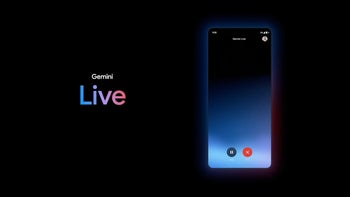



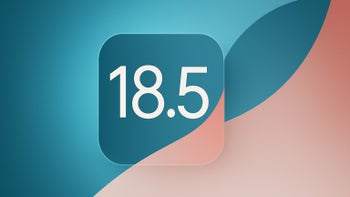
Things that are NOT allowed: